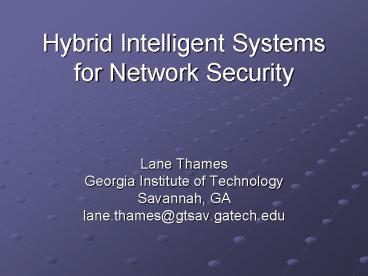Hybrid Intelligent Systems for Network Security PowerPoint PPT Presentation
1 / 31
Title: Hybrid Intelligent Systems for Network Security
1
Hybrid Intelligent Systems for Network Security
- Lane Thames
- Georgia Institute of Technology
- Savannah, GA
- lane.thames_at_gtsav.gatech.edu
2
Presentation Overview
- Discuss the goals of this project
- Overview of Self Organizing Maps
- Overview of Bayesian Learning Networks
- Describe the details of the Hybrid System
- Review the Experimental Results
- Discuss Conclusions and Future Work
- QA
3
Internet Growth
- Internet Growth is Steadily Increasing
- Many different types of applications are now
using the Internet as a communication channel
4
Data Source www.idc.com
5
The life of a network security professional
6
Data Source http//www.cert.org/stats/cert_stats.
html
7
Current Issues with Security
- Short time between disclosure of vulnerability
and attack - Huge Rule Base
- Huge Signature Databases
- Lag time between attack detection and signature
creation - Lag time between vulnerability discovery and
patch deployment
8
Project Goals
- Develop an Intelligent System that works reliably
with data that can be collected purely within a
Computer Network - Why? If security mechanisms are difficult to
use, people will not use them. - Using data from the network takes some of the
burden off the end user
9
Hybrid Intelligent Systems
- A system was developed that made use of two types
of Intelligence Algorithms - Self-Organizing Maps
- Bayesian Learning Networks
10
Training and Testing Data Set
- KDD-CUP 99 Data Set
- The Data set used for the Third International
Knowledge Discovery and Data Mining Tools
Competition
11
Training and Testing Data Set
- 41 Total Features Categorized as
- Basic TCP/IP features
- Content Features
- Time Based Traffic Features
- Host Based Traffic Features
12
Self Organizing MapsSOM
- Pioneered by Dr. Teuvo Kohonen
- An algorithm that transforms high dimensional
input data domains to elements of a low
dimensional array of nodes
13
Self-Organizing Maps
- Input Data Vectors
- Parametric Vector associated with each element,
i, of the grid
14
Self-Organizing Map
- A decoder function is defined on the basis of
distance between the input vector and the
parametric vector. - The decoder function is used to map the image of
the input vector onto the SOM grid. The decoder
function is usually chosen to be either the
Manhattan or Euclidean distance metric.
15
Self-Organizing Maps
- A Best Matching Unit, denoted as the index c, is
chosen as the node on the SOM grid that is
closest to the input vector
16
Self-Organizing Maps
- The dynamics of the SOM algorithm demand that the
Mi be shifted towards the order of X such that a
set of values Mi are obtained as the limit of
convergence of the following
17
Bayesian Learning NetworksBLN
- A BLN is a probabilistic model, and the network
is built on the basis of a Directed Acyclic Graph
(DAG) - The directed edges of the graph represent
relationships among the variables
18
Bayesian Learning Networks
- The Fundamental Equation Bayes Theorem
19
Bayesian Learning Networks
- In Bayesian learning, we calculate the
probability of an hypothesis and make predictions
on that basis
20
Bayesian Learning Networks
- With BLN, we have conditional probabilities for
each node given its parents - The graph shows causal connections between the
variables - Prediction and abduction
x4
21
Naïve Bayesian Learning Network
- The Naïve BLN is a special case of the general
BLN - It contains one root node which is called the
class variable, C - The leaf nodes are the attribute variables
(X1 Xi) - It is Naïve because it assumes the attributes are
conditionally independent given the class
x1
22
The Naïve BLN Classifier
- Once the network is trained, it can be used to
classify new examples where the attributes are
given and the class variable is
unobservedabduction - The Goal Find the most probable class value
given a set of attribute instantiations (X1 Xi)
23
Hybrid System Details
SOM Training
Training Data Subset
24
Hybrid System Details
Data
Trained SOM
Modified Data
BN Development Module
25
Hybrid System Details
BN Development Module
Training Data
Structure File
Bayesian Training
26
Hybrid System Details
Bayesian/SOM Classifier
Test Data
Classification File
27
Experimental Results
- 4 types of analyses were made with the dataset
- BLN analysis with network and host based data
- BLN analysis with network data
- Hybrid analysis with network and host based data
- Hybrid analysis with network based data
28
Experimental Results
29
Future and Current Work
- HoneyNet Project
- Resource Management System with Intelligent
System Processing at the Core
30
Conclusions
- Intelligent System algorithms are very useful
tools for applications in Network Security
31
Conclusions
- Questions remain to be answered
- How will the system behave as the data becomes
very noisy with respect to training data - How will other intelligence algorithms compare in
performancetraining time, accuracy, robustness
in noise

